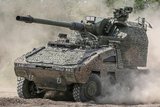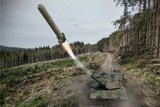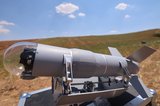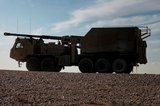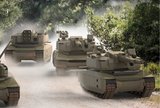General Dynamics' AVC design undergoes testing
General Dynamics Land Systems has announced that it recently conducted simulated mine-blast tests that confirm the ability of its Amphibious Combat Vehicle (ACV) ballistic hull design to meet the US Marine Corps' (USMC’s) current ACV mine-blast survivability requirements.
The tests, funded through General Dynamics' internal research and development initiatives, were conducted by National Technical Systems at the National Ordnance and Ballistic Test Center. The company said that successful tests simulated an underbelly mine-blast event on the forward and aft sections of the General Dynamics ACV ballistic hull.
According to the tests, the vehicle’s hull design meets the Marine Corps' ACV survivability requirement. The tests also provided an early assessment of the levels of protection against threshold and objective threat levels that the new hull design will provide to the USMC.
Michael Bolon, senior vice president, Marine and Navy sector at General Dynamics Land Systems, said: ‘General Dynamics Land Systems continues to invest in support of the US Marine Corps' development efforts toward a modern Amphibious Combat Vehicle. The successful results of these company-funded tests reinforce our confidence in our ability to deliver a low-risk Amphibious Combat Vehicle solution with mature and affordable technology, drawing on the industry's broadest base of amphibious combat vehicle knowledge and experience to deliver solutions that meet the Marine Corps' requirements.’
In addition to evidence of the hull design's survivability characteristics, this test also provides empirical data to correlate survivability models that will be used to refine and confirm performance of the General Dynamics' hull design, which will also be tested by the government under the ACV Hull Survivability Demonstrator contract.
The ACV Hull Survivability Demonstrator contract, awarded in August 2012, is for the design, fabrication and test support of a full-scale hull to demonstrate crew-protection technologies. Work will conclude by May 2013 and will be used to refine ACV requirements for effective protection against threats from under-vehicle blasts and fragmentation devices.
More from Land Warfare
-
![Dedicated drone munitions could unlock modular mission potential]()
Dedicated drone munitions could unlock modular mission potential
Top attacks have proven effective against heavily armoured vehicles in Ukraine. A new family of uncrewed aerial system-delivered munitions is looking to press that advantage further.
-
![Elbit bets on local content for US howitzer bid as it faces off against popular systems]()
Elbit bets on local content for US howitzer bid as it faces off against popular systems
The Israeli company hopes that producing its Sigma artillery system wholly in the US will help it win a key US Army contract, but it will be up against the popular CAESAR Mk II wheeled weapon and the K9 tracked.
-
![Rheinmetall and KNDS tank tie-up narrows trans-European options]()
Rheinmetall and KNDS tank tie-up narrows trans-European options
The French and German governments signed an agreement in June 2018 to cooperate on the development of a new main battle tank under the Main Ground Combat System programme but the effort has struggled. This new agreement may damage it further.








